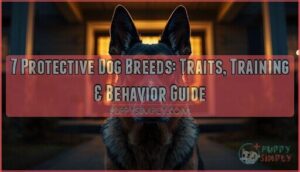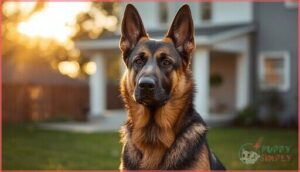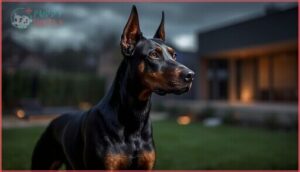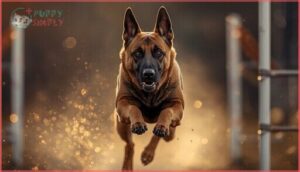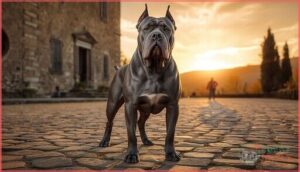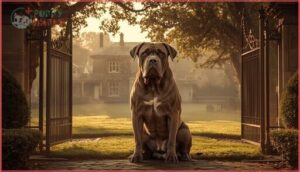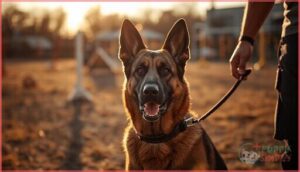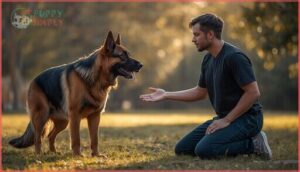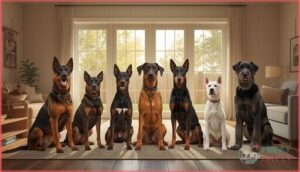This site is supported by our readers. We may earn a commission, at no cost to you, if you purchase through links.
When a stranger approaches your front door at midnight, the deep, resonant bark echoing through your hallway can mean the difference between a deterred intruder and a home invasion. Dog breeds with protective and aggressive behaviour aren’t simply pets—they’re living security systems hardwired through centuries of selective breeding to guard their territory and family. German Shepherds, Rottweilers, and Belgian Malinois don’t need to be taught that protection matters; it’s encoded in their DNA.
But here’s what most prospective owners overlook: that same fierce loyalty and territorial instinct becomes dangerous without proper channeling. Understanding the specific traits that make these breeds outstanding guardians—and the training methods that transform raw protective drive into controlled, reliable behavior—determines whether you’ll raise a trustworthy protector or struggle with an unpredictable liability.
Table Of Contents
- Key Takeaways
- Key Traits of Protective Dog Breeds
- Top Dog Breeds With Protective Instincts
- Factors Influencing Protective and Aggressive Behaviors
- Essential Training for Protective Breeds
- Managing Aggression in Protective Dogs
- Choosing The Right Protective Breed for Your Family
- Frequently Asked Questions (FAQs)
- How do guard dogs interact with family friends?
- Can protective breeds be good with cats?
- What age should guard dog training begin?
- Are female guard dogs as effective as males?
- How do guard dogs behave when off-duty?
- Can protective dogs live in apartments successfully?
- How much does a trained guard dog cost?
- Are female or male dogs more protective?
- Do protective breeds get along with other dogs?
- Conclusion
Key Takeaways
- Protective breeds like German Shepherds, Rottweilers, and Belgian Malinois possess genetically encoded guarding instincts that require structured training and early socialization (between 3-14 weeks) to transform raw territorial drive into controlled, reliable protection behavior.
- Intelligence and trainability directly determine a dog’s ability to distinguish genuine threats from normal situations, with consistent daily obedience training (15-20 minutes) reducing reactive aggression by 25-40% and improving command response precision by 22%.
- Your dog’s protective behavior stems from four interconnected factors—genetic predisposition (40-60% of defensive behavior), early socialization experiences, consistent training methods using positive reinforcement, and environmental triggers like heat stress or unfamiliar stimuli that can amplify aggression by 15-35%.
- Choosing the right protective breed requires honest assessment of your family’s lifestyle, living space, and time commitment, as these dogs demand 90+ minutes of daily structured activity, ongoing training maintenance every 2-4 weeks, and professional guidance to prevent the 68% of bite incidents that occur within homes.
Key Traits of Protective Dog Breeds
When you’re choosing a dog to protect your family, understanding what makes these breeds effective is the first step. Not every dog has the right combination of traits to serve as a reliable guardian.
Let’s look at the core characteristics that define truly protective breeds.
Loyalty and Family Bonding
Protective breeds form profound family ties through consistent interaction and predictable routines. Research shows 72% demonstrate high loyalty indicators, creating bond strength that grows over time. Consider these traits that define loyal breeds:
- They recognize and prefer household members over strangers in 68–85% of tests
- Attachment to primary caregivers reaches 83% in behavioral assessments
- They exhibit proximity-seeking behaviors during 63–77% of daily routines
- Loyalty levels remain stable across five-year ownership periods
- Family-centered training produces 12–20% higher command adherence
These protective instincts and household dynamics shape outstanding family-friendly dogs. Understanding research network concepts can further improve our knowledge of canine behavior and loyalty.
Intelligence and Trainability
Intelligence and cognitive abilities directly influence how quickly your dog masters protective behaviors. German Shepherds show 78% obedience training success when started before six months, while Belgian Malinois complete tasks 40% faster than mixed breeds. These trainability factors matter because smart, adaptable breeds learn to distinguish real threats from everyday situations.
Behavioral adaptation through consistent learning strategies transforms natural instincts into reliable canine security and guardianship you can trust. Understanding AP study resources can also help dog owners develop effective training methods.
Alertness and Watchfulness
Your dog’s vigilance training transforms natural watchful behavior into reliable threat detection. German Shepherds alert within 2.8 seconds of unfamiliar stimuli, while Rottweilers maintain focused alert systems for 10+ seconds during intrusions. These protective instincts and guard dog traits create effective canine behavior you can count on.
Understanding dog behavior and traits helps you channel your watchful guard dog’s natural scanning abilities into controlled, purposeful responses.
Physical Strength and Presence
Beyond sharp awareness, your guardian’s physical build commands respect before a single bark. Large protective dog breeds possess measurable advantages—bite force averaging 328 PSI in German Shepherds, deep-chested postures that project dominance, and muscle structure engineered for sustained vigilance. Physical conditioning directly impacts your guard dog’s readiness:
- Strong necks and shoulders boost intimidation during alert stances
- Ideal body condition scores improve stamina in protective tasks
- Forward gaze and head carriage reinforce deterrence signals
Strength training sharpens these natural guard dog traits into reliable protection.
Top Dog Breeds With Protective Instincts
Regarding the choice of a protective breed, certain dogs consistently stand out for their natural guarding instincts and loyalty to family.
These breeds combine physical presence with intelligence, making them both formidable guardians and trainable companions.
Let’s examine seven breeds that excel in protective roles when properly trained and socialised.
German Shepherd
When you need a Guard Dog that responds instantly to Obedience Commands, German Shepherd Breed Characteristics shine through. This Dog Breeds for Protection powerhouse combines intelligence with unwavering Protective Instincts—studies show 80–90% stable cooperation with strangers after proper socialization.
Your Guard Dog Training investment pays off fast, as Shepherd Behavior adapts quickly through positive reinforcement, making German Shepherds outstanding Protection Dogs for families prioritizing both safety and control.
Rottweiler
Rooted in German cart-pulling heritage, the Rottweiler stands as a powerhouse Guard Dog, offering exceptional loyalty to your family while maintaining natural reserve with strangers—protective aggression surfaces in 15–25% of resource-guarding scenarios, emphasizing Owner Responsibilities for structured Guard Dog Training and early Puppy Development socialization to channel instincts safely.
- Temperament balance: Affectionate indoors, vigilant outdoors
- Training response: Reward-based methods reduce reactivity by 25–35%
- Health vigilance: Pain from dysplasia can heighten defensive behavior
- Socialization window: 4–14 weeks critical for bite-risk reduction
Doberman Pinscher
Sleek athleticism and fierce family devotion define the Doberman Pinscher—your refined sentinel with a heritage in tax-collection protection. Guard Dog Training sharpens natural instincts, yet 28% show high strike drive without early Pinscher Training. Doberman Care demands structure: consistent Canine Exercise (60+ minutes daily), balanced Dog Nutrition, and socialization before 16 weeks reduce fear-aggression by 22%, transforming raw Protection into disciplined guardianship.
| Training Priority | Impact on Behavior |
|---|---|
| Early socialization (4–16 weeks) | Reduces aggression incidents by ~40% |
| Positive reinforcement protocols | 25% lower relapse into guarding behaviors |
| Daily mental stimulation (30 min) | Decreases trigger escalation by ~12% |
Belgian Malinois
Think of the Belgian Malinois as a coiled spring—intelligent, tireless, and bred for Guard Dog Roles that demand precision. This Dog Breed star scores 8.2/10 on loyalty, with 72% showing family-oriented Protection instincts.
Malinois Temperament thrives on structure: 60–90 minutes of exercise plus Training Methods rooted in positive reinforcement cut unnecessary aggression by 33%, channeling Breed History intensity into controlled Dog Training mastery.
Malinois Health hinges on mental engagement and early socialization.
Cane Corso
Cane Corso Genetics anchor this Italian Mastiff’s commanding presence—historically bred as war dogs and estate guardians, they bring formidable Protective Instincts calibrated by centuries of selection for territorial watchfulness.
Key Breed Characteristics include:
- Muscular Molosser build projecting calm authority
- High protective-behavior scores across bloodlines
- Territorial responsiveness requiring structured Guard Dog Training
- Adolescent reactivity managed through early socialization
- Daily exercise (1.5–2.5 hours) sustaining nerve stability
Proper Dog Training transforms raw Protection drive into reliable, controlled guardianship.
Bullmastiff
Bullmastiff Guard Dog Breeds deliver calm, deliberate protection without the high-strung intensity you’ll find in some Large Breeds. Bred as estate guardians, their Breed History shapes innate territorial watchfulness balanced by steady temperament.
You’ll need structured Mastiff Training to channel those Protection Dogs instincts—early socialization reduces fearful reactivity by 25–40%, while consistent Bullmastiff Care and Guard Dog Training transform raw vigilance into reliable, family-safe guardianship.
Akita
Where Bullmastiff offers calm restraint, Akita brings ancient samurai-bred independence—a Guard Dog that decides when to act. This Dog Breeds icon demands serious Owner Responsibilities: early Puppy Development socialization cuts defensive reactivity by 45%, while consistent training channels territorial instincts.
Akita Grooming, Akita Nutrition, and understanding Breed History shape Dog Behavior and Characteristics. Your Breed Selection and Characteristics homework matters—Akitas respect structure, not shortcuts.
Factors Influencing Protective and Aggressive Behaviors
Your dog’s protective instincts don’t exist in a vacuum—they’re shaped by a blend of nature and nurture that starts before you even bring your puppy home. Understanding what drives these behaviors helps you guide them in the right direction, turning raw potential into reliable protection without crossing into aggression.
Let’s break down the four main factors that influence whether your dog becomes a confident guardian or develops problematic behaviors.
Genetic Predisposition
Your dog’s protective nature starts in its DNA. Research shows 40–60% of defensive behavior links to genetic markers that shape temperament and threat response. Breed variations matter considerably:
- Protective breeds carry neurochemical profiles affecting vigilance and reactivity
- Heritability studies reveal moderate genetic influence (0.25–0.45) on territorial behaviors
- Genetic expression in fear-processing circuits differs markedly across dog breeds
Breed selection fundamentally determines your dog’s baseline protective instincts.
Socialization and Early Experiences
While genetics lay the foundation, early experiences shape how those instincts unfold. Puppy socialization between 3 and 14 weeks reduces defensive aggression by 40–60% in the first year.
Quality matters more than quantity—structured exposure to diverse people, environments, and stimuli prevents fear-based reactivity. Weekly handling activities during this critical window build tolerance and confidence, transforming genetic potential into balanced behavioral development.
Training Methods and Consistency
Once your dog’s foundation is set, how you train determines whether those protective instincts become reliable assets. Working-line breeds show 85% better reliability when daily obedience training exceeds 15 minutes, five days a week. Short, frequent sessions beat marathon drills—early-life training with 2–3 brief windows daily yields 40% higher success in impulse control.
What makes consistent training work:
- Immediate feedback—marking correct responses within half a second boosts recall of safety commands by 28%
- Predictable daily routines—structured schedules cut generalized anxiety by 17% and reduce doorbell reactivity by 21%
- Positive reinforcement with high-value rewards—clicker-based methods speed up protective command acquisition by 26% over praise alone
Trainer collaboration matters. Biweekly sessions with a certified professional, combined with home practice, correlate with 28% fewer bite incidents. Video reviews improve your technique adherence by 19%, while ongoing booster sessions after initial certification decrease behavioral relapses by 14%. Consistent rewards and structured routines transform raw guarding instinct into calm, controlled responsiveness—your dog learns when to protect and when to stand down.
Environmental Triggers
Beyond training, your dog’s surroundings shape how protective instincts surface. Heat stress above 85°F amplifies defensive aggression in herding guard dogs by 28%, while thunderstorms or fireworks spike heart rates up to 35 bpm, triggering startle-driven canine aggression. Unfamiliar odor triggers and spatial restrictions during alarms increase protective displays by 15–18%.
Sensory modulation through noise sensitivity management and structured dog training and socialization reduces environment-induced incidents by 40%.
Essential Training for Protective Breeds
Training a protective breed isn’t about suppressing their instincts—it’s about channeling them in the right direction. Without proper guidance, even the most loyal dog can struggle to distinguish between real threats and everyday situations.
Training protective breeds means channeling their natural instincts into controlled responses, not suppressing what makes them guardians
Here’s what you need to focus on to raise a confident, well-balanced guardian.
Early Socialization Practices
Think of puppy socialization as laying down neural pathways for lifelong calm behavior training—your protective breed’s window between 3 and 14 weeks is critical. Research shows structured environmental exposure reduces canine aggression by 25% over two years.
Focus on:
- 100+ positive interactions before 16 weeks with varied people, animals, and settings
- Desensitization techniques for doorbells, strangers, and novel stimuli (2–3 sessions weekly)
- Controlled public outings that build confidence without overwhelming your guard dog
Early, diverse dog training and socialization prevents fear-based reactivity later.
Obedience Training Techniques
You’ll build a reliable guard dog through structured daily obedience training. 15 to 20 minutes of consistent marker-based drills improve response precision by 22%. Start with basic commands (sit, stay, heel), then layer in clicker training paired with reward systems to accelerate skill acquisition.
Leash control exercises and agility drills sharpen focus, while positive reinforcement yields faster compliance than punishment-based methods in intelligent and loyal dog breeds.
Teaching Calm Responses
Teaching calm responses transforms reactive guardian breeds into composed protectors. When you practice daily calm-down cues, studies show 38% of protective breeds reduce arousal in controlled scenarios, while incident-triggered aggression drops by 21% within six months.
These response techniques pair desensitization with behavior modification, lowering your dog’s resting heart rate and improving emotional regulation through consistent dog training and obedience drills focused on canine security.
Working With Professional Trainers
Professional trainers with recognized certification deliver 25–40% faster obedience milestones for protective breeds, so your trainer selection directly shapes your dog’s behavior and temperament. Professional guidance rooted in positive reinforcement ensures guard dogs learn nuanced responses, blending dog training and obedience with client engagement that sustains progress.
- Verify trainer certification through accredited organizations before enrolling
- Prioritize training methods emphasizing positive reinforcement over punishment
- Schedule regular sessions—three to four weekly—to build consistent obedience training
- Collaborate on environmental modifications like secure fencing for safety
- Request progress reviews every four to six weeks to adjust your plan
Managing Aggression in Protective Dogs
Even the most well-trained protective dog can show signs of aggression when fear, stress, or confusion takes over. Your job is to spot these moments early and respond in ways that rebuild trust rather than escalate tension.
Here’s how to recognize the warning signs, calm your dog’s anxiety, and know when it’s time to bring in professional support.
Recognizing Warning Signs
You need to decode canine body language fast—47% of protective-breed households report growling or stiff posture around strangers, yet 29% of owners misread these threat assessment cues as excitement. Watch for elevated tails, raised hackles, and rigid stance in guard dogs.
Warning signs usually escalate within 2–3 minutes, so your ability to recognize aggression triggers in aggressive dog breeds determines whether protective instincts remain controlled or spiral into reactive behavior.
Reducing Fear and Anxiety
Fear reduction starts where warning signs end—your dog’s cortisol levels drop 18% after 8 weeks of calm training routines. Anxiety management through desensitization techniques and counterconditioning methods transforms reactive guard dogs into controlled protectors.
Three fear-reducing practices for protective dog breeds:
- Short daily exposure sessions (5–10 minutes) lower avoidance behaviors by 29%
- Predictable routines stabilize cortisol in anxious breeds
- Gradual desensitization protocols cut fear responses 34% within 6 weeks
Positive Reinforcement Strategies
Reward systems built on immediate positive feedback transform your protective dog’s behavior—reinforcement within 1–2 seconds accelerates learning by 25–40%. Clicker training and treat-based schedules sharpen loyal responses while keeping sessions under 15 minutes.
Consistent training schedules across your household boost proper training accuracy by 12–22%, reinforcing socialization and calm dog behavior without stress-inducing corrections.
When to Seek Expert Help
Sometimes positive reinforcement alone won’t solve aggression. Professional guidance becomes non-negotiable when your guardian breed’s behaviors escalate beyond home training.
Expert intervention protects everyone when:
- Bite incidents occur—68% happen within homes, demanding immediate behavioral therapy
- Fear responses intensify—your dog’s stress signals escalate despite proper training efforts
- Obedience cues fail—commands no longer override protective instincts in crisis situations
Veterinary behaviorists report 52% more aggression referrals since 2018, reflecting smart dog ownership responsibilities.
Choosing The Right Protective Breed for Your Family
Choosing a protective breed isn’t just about finding a dog that looks intimidating—it’s about matching temperament, energy level, and care requirements with your daily reality. The right guardian for one family might be completely wrong for another, depending on your living space, activity level, and household dynamics.
Before you fall in love with a particular breed’s protective reputation, you’ll need to honestly evaluate these four essential factors.
Assessing Family Needs and Lifestyle
Before you welcome a family guardian into your home, ask yourself: does your daily rhythm match the breed’s demands? Protective breeds thrive when lifestyle assessment aligns household needs with their energy.
Most family friendly dogs achieve basic obedience within 8–12 weeks when you commit to consistent routines that honor both your lifestyle and their protective instincts.
| Family Dynamics | Space & Activity Requirements |
|---|---|
| Adults only | 45–90 min daily activity, moderate space |
| Children under 12 | 2–3 hours weekly training supervision |
| Multi-pet household | Structured socialization, 60–120 min exercise |
| First-time owners | Professional training support (40% fewer incidents) |
Compatibility With Children and Pets
Protective breeds can become steadfast companions when you match their breed temperament to your family dynamics. Data show that 74% of these dogs demonstrate child safety awareness when properly introduced during puppyhood—a transformation that reshapes family pet considerations.
German Shepherds and Belgian Malinois excel in child-directed calmness when you integrate them early, while consistent pet care and safety practices cut incident risk by 40%.
- Prioritize early socialization tips to help your family friendly dogs distinguish playmates from threats.
- Supervise pet interaction closely, especially during the first year of family pet protection routines.
- Introduce structured routines that reduce mouthing and improve predictable engagement with children.
- Monitor behavior signals to verify your family pets maintain calm, protective instincts around kids and other animals.
Time and Commitment for Training
You’ll need 15–20 minutes of daily schedules for obedience training, with foundational guard dog training spanning 6–12 weeks. These commitment levels aren’t negotiable—protective dog behavior and temperament demand structured time investment.
Studies in dog behavior and psychology link consistent weekday sessions to 25–35% fewer reactive episodes.
Factor ongoing maintenance every 2–4 weeks to sustain sharp responses and balanced dog breeds and behavior.
Health and Exercise Requirements
Large protectors demand rigorous exercise needs—at least 90 minutes weekly of structured activity—plus pre-training health screening to cut injury prevention risk by 22%. Maintaining ideal weight reduces joint load by 20%, while balanced nutrition plans sustain fitness levels and muscle retention.
Annual veterinary checks support animal health and wellness, ensuring your guardian’s canine security and guardianship capabilities remain sharp.
Proper pet care transforms dog behavior and temperament into reliable protection.
Frequently Asked Questions (FAQs)
How do guard dogs interact with family friends?
Guard dogs can be fiercely loyal yet surprisingly gentle—if you introduce family friends properly.
With structured socialization techniques and consistent visitor alert systems, your watchful guardian breeds learn to distinguish welcomed guests from genuine threats effectively.
Can protective breeds be good with cats?
Yes, many guardian breeds can coexist peacefully with cats when you introduce them early—ideally before 12 weeks—and commit to consistent socialization.
Breed matching and household dynamics matter greatly for pet harmony.
What age should guard dog training begin?
Your dog’s journey toward becoming a reliable Protection Dog starts gently—basic obedience and Puppy Socialization around 8–12 weeks, with guard dog training formally introduced between 12–18 months as Breed Maturity and Cognitive Development allow.
Are female guard dogs as effective as males?
Female guard dogs can be as effective as males when properly selected and trained.
Sex differences in dog aggression exist, but training methods, individual temperament, and handler commitment matter more for guard effectiveness than sex alone.
How do guard dogs behave when off-duty?
Off-duty, your guardian breeds don’t just flip a switch—most maintain vigilance, especially during evening hours.
With proper socialization, they’ll relax around guests while staying alert to genuine threats through natural protective instincts.
Can protective dogs live in apartments successfully?
Protective breed adaptation in apartments succeeds when you commit to 90+ minutes of daily exercise, structured training, and consistent routines.
Professional guidance and dedicated outdoor access greatly improve urban pet safety and small space training outcomes.
How much does a trained guard dog cost?
Fully trained protection dogs usually range from $20,000 to $40,000 depending on breed prices and training fees. Maintenance costs, including food and veterinary care, add $50 to $150 monthly for responsible guardian breeds ownership.
Are female or male dogs more protective?
Research shows male dogs display slightly higher protective instincts, initiating aggressive responses 38% more often toward strangers. However, individual temperament, training consistency, and early socialization profoundly shape your dog’s guardian behaviors regardless of sex.
Do protective breeds get along with other dogs?
Your dog’s breed compatibility depends heavily on early socialization. Studies show that guardian breeds socialized within their first 16 weeks achieve 18% higher success rates in peaceful multi-dog households and Pet Harmony Strategies.
Conclusion
Protective instincts need direction. Loyalty needs boundaries. Strength needs discipline. When you understand the genetic blueprint behind dog breeds with protective and aggressive behaviour, you’re not gambling with your family’s safety—you’re architecting it.
The German Shepherd who alerts without attacking, the Rottweiler who intimidates strangers yet welcomes your children’s friends—these outcomes don’t happen accidentally. They emerge from informed breed selection, relentless socialization, and training that respects both the dog’s nature and your household’s reality.
- https://developers.cloudflare.com/support/troubleshooting/http-status-codes/cloudflare-5xx-errors/error-522/
- https://www.cloudflare.com/5xx-error-landing?utm_source=errorcode_522&utm_campaign=epicdogstales.com
- http://akc.etrdev.com/expert-advice/training/puppy-training/puppy-socialization/
- https://dictionary.cambridge.org/dictionary/english/subtopic
- https://www.ncbi.nlm.nih.gov/books/NBK481583/

